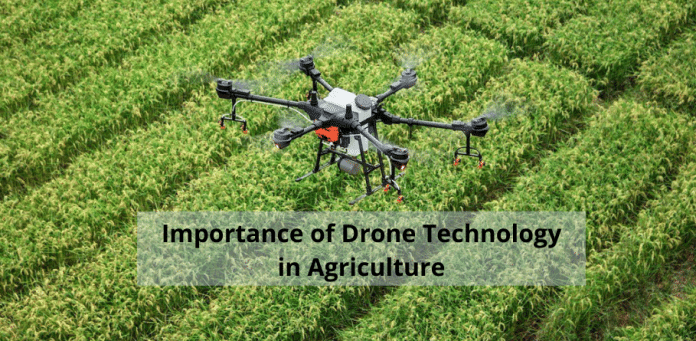Drones are becoming increasingly important in agriculture and many farmers are going in for drone purchases in these modern days. Farmers are nowadays relying on high-level drone technology that can provide them with fast and efficient solutions.
The agricultural industry is now embracing drone technology and using these sophisticated tools to transform modern farming. The use of drones in agriculture is currently helping agricultural businesses meet the changing and growing demands of the future. Moreover, high-tech drones permit farmers, and the drone pilots that operate them, to increase efficiency in certain aspects of the farming process, from crop monitoring to planting, livestock management, crop spraying, irrigation mapping, and more.
Drones collect raw data and convert it into useful information. Therefore, they can be used for various applications in drone farming, such as monitoring the following parameters:
- Crop health -Damage made by insects; color change due to pest infection
- Vegetation indices- Leaf area, anomaly detection, treatment effectiveness, phenology, yield
- Plant height – Plant height and density
- Plant scouting- Plant size, plot statistics, stand number, compromised plots, planter skips
- Water requirements – Water-stressed parts of the field/orchard in need of watering
- Soil analysis-Nutrient availability for plant nutrient management
Best Drone Practices
- Soil and field analysis: The drone survey allows farmers to get information about their land’s soil conditions. Multispectral sensors capture data that may be used for seed planting patterns, field soil analysis, irrigation, and nitrogen control. Farmers may comprehensively examine their soil conditions using precise photogrammetry/ 3D mapping.
- Planting: Planting seeds is one of the latest and less common uses of drones in agriculture. Planting with drones can help you to reach areas that can be replanted without endangering workers. With a team of two operators and 10 drones capable of planting 400,000 trees each day, they can also plant significantly more effectively.
- Crop spraying: The use of drones to provide spray treatments is already common in some areas. Drone sprayers for agriculture can reach locations that are difficult to reach, like steep tea plantations at high heights. Drone sprayers eliminate the need for personnel to traverse fields with backpack sprayers, which can be dangerous to their health. Drone sprayers apply very tiny spray treatments that may be targeted to particular locations, increasing efficiency and lowering chemical costs.
- Crop monitoring: The biggest challenge in farming is the size of the fields and the inefficiency of crop monitoring. Increasingly variable weather conditions worsen monitoring issues, increasing risk and field maintenance costs. Previously, satellite imagery was the most advanced form of monitoring. But there were drawbacks too. Drones can provide precise field mapping including elevation information that allows growers to find any irregularities in the field. Knowing the elevation of a field helps determine drainage patterns and wet/dry zones, allowing for more effective watering tactics.
- Irrigation: Drones equipped with hyperspectral, multispectral, or thermal sensors can detect areas of a field that are dry or in need of improvement. Drones can also calculate the vegetation index, which indicates the relative density and health of the crop and reveal the heat signature, which is the amount of energy or heat the crop releases, once the crop is growing
- Health check: Assessing crop health and spotting bacterial or fungal infestations on trees is critical. Drone-borne equipment can distinguish which plants reflect various quantities of green light and near-infrared light by scanning a crop with both visible and near-infrared light. This data may be used to create multispectral pictures that track plant changes and indicate their health.
A quick response may be able to rescue a whole orchard. Furthermore, once a disease has been identified, farmers may more accurately administer and monitor treatments. These two options improve a plant’s capacity to resist illness. In the event of crop failure, the farmer will be able to easily document losses for insurance claims.
Benefits of Drone Technology
As innovators introduce new technologies, their commercial uses increase day by day. As drone technology solutions become more common, it also becomes more cost-effective. In agriculture, they have a plethora of advantages. Some are as follows:
Enhanced Production – The farmer can enhance production capabilities through comprehensive irrigation planning, adequate monitoring of crop health, increased knowledge about soil health, and adaptation to environmental changes.
Effective and Adaptive Techniques – Drone use allows farmers to receive regular information on their crops and aids in the development of more effective agricultural practices. They can adjust to changing weather conditions and utilize resources efficiently.
Greater safety of farmers – Using drones to spray pesticides in difficult-to-reach terrains, contaminated areas, higher crops, and power lines is safer and more convenient for farmers. It also helps farmers avoid crop spraying, resulting in less pollution and chemicals in the soil.
Faster data for quick decision-making – Drone surveys provide farmers with reliable data processing, allowing them to make quick and deliberate judgments without second-guessing, saving time spent on crop scouting. The drone’s various sensors allow it to capture and analyze data from the entire field. The information may be used to target issue regions such as sick or unhealthy crops, various colored crops, moisture levels, and so on. The drone may be outfitted with a variety of sensors for different crops, allowing for a more precise and flexible crop management system.
Less wastage of resources – Drones in agriculture enables optimum usage of all resources such as fertilizer, water, seeds, and pesticides.
99% Accuracy rate – The drone survey helps farmers calculate the exact land size, segment the various crops, and indulge in soil mapping.
Useful for Insurance claims – Farmers utilize the data collected by drones to file crop insurance claims in the event of damage. While being insured, they even analyze the risks and losses linked with the land.
Evidence for insurance companies – Agricultural drones are used by agricultural insurance companies for efficient and reliable data. They document the damage that has happened to calculate the appropriate monetary compensation for the farmers.
Drones have changed the course of obtaining data in almost every type of industry, and will only deem to become bigger and better in the coming years. Drones have already vastly altered the agricultural industry and will continue to grow in the coming years. While drone use is becoming more useful to small farmers, there is still a way to go before they become part of every farmer’s equipment roster, particularly in developing nations.
Ready to start Agricultural Drones Services? Contact KnackForge’s Drone technology experts Today to Get Started!
About the Author
Abdul is a certified Drone engineer at KnackForge, responsible for developing and expanding its drone industry research portfolio for the past 5 years. He is from Tyler, Texas, and his drone technology articles were featured in many blogs.












